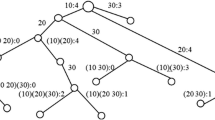Abstract
Mining sequential patterns from large databases has been recognized by many researchers as an attractive task of data mining and knowledge discovery. Previous algorithms scan the databases for many times, which is often unendurable due to the, very large amount of databases. In this paper, the authors introduce an effective algorithm for mining sequential patterns from large databases. In the algorithm, the original database is not used at all for counting the support of sequences after the first pass. Rather, a tidlist structure generated in the previous pass is employed for the purpose based on set intersection operations, avoiding the multiple scans of the databases.
Similar content being viewed by others
References
Chen Ming-Syan, Han Jiawei, Yu Philip S. Data mining: An overview from a database perspective.IEEE Transactions on Knowledge and Data Engineering, Dec., 1996, 8(6): 866–883.
Rakesh Agrawal, Tomasz Imielinski, Arun Swarni Mining association rules between sets of items in large databases. InProceedings of ACM SIGMOD, May, 1993, pp. 207–216.
Chen Ning, Zhon Longxiang. Data mining in Internet.Computer Science, 1999, 26(7): 44–49. (in Chinese).
Rakesh Agrawal, Ramakrishnan Srikant. Mining sequential patterns. InProceedings of Data Engineering Conference, Taipei, March, 1995, pp. 3–14.
Houtsma M, Swami A. Set-oriented mining of association rules. Research Report RJ 9567, IBM Almaden Research Center, San Jose, California, October, 1993.
Rakesh Agrawal Ramakrishnan Srikant, Fast algorithm for mining association rules, InProceedings of the 20th VLDB Conference, Santiago, Chile, 1994, pp. 487–499.
Park J-S, Chen M-S, Yu P S. An effective Hash based algorithm for mining association rules. InProceedings of ACM SIGMOD, May, 1995, pp. 175–186.
Savasere A, Omiecinski E, Navathe S. An efficient algorithm for mining association rules in large databases. InProceedings of International Conference of VLDB, 1995, pp. 432–444.
Mohammed Javeed Zaki, Srinivasan Parthasarathy, Mitsunori Ogihara, Wei Li. Parallel algorithms for discovery of association rules.Data Mining and Knowledge Discovery, 1997, 1(4): 343–373.
Chen Ning, Chen An. Discovery of multi-level sequential patterns from large database. InProceedings of the International Symposium on Future Software Technology, Software Engineers Association, Nanjing, China October 24–30, 1999, pp. 169–174.
Author information
Authors and Affiliations
Corresponding author
Additional information
CHEN Ning was born in 1974. She received her B.S. and M.S. degrees from Department of Computer Science of Shandong University in 1994 and 1997, respectively. She received the Ph.D. degree from Academy of Mathematics and System Science, The Chinese Academy of Sciences in 2001. Her current research interests include data mining and knowledge discovery.
CHEN An was born in 1970. He received his M.S. degree from School of Mathematics and System Science of Shandong University in 1997. He received the Ph.D. degree from Beijng University of Aeronautics and Astronautics in 2001. He is now an assistant professor in the Institute of Plicy and Management, The Chinese Academy of Sciences. His current research interests include supply chain management and E-commerce.
ZHOU Longxiang was born in 1938. He is now a professor of Academy of Mathematics and System Science, The Chinese Academy of Sciences. His research interests include distributed database, data mining, E-commerce, and data warehouse.
LIU Lu was born in 1947. She received her M.S. degree from Beijing Polytechnic University in 1988. She is a professor of Beijing University of Aeronautics and Astronautics. Her research interests include MIS, supply chain and E-commerce.
Rights and permissions
About this article
Cite this article
Chen, N., Chen, A., Zhou, L. et al. A fast algorithm for mining sequential patterns from large databases. J. Comput. Sci. & Technol. 16, 359–370 (2001). https://doi.org/10.1007/BF02948984
Received:
Revised:
Issue Date:
DOI: https://doi.org/10.1007/BF02948984




